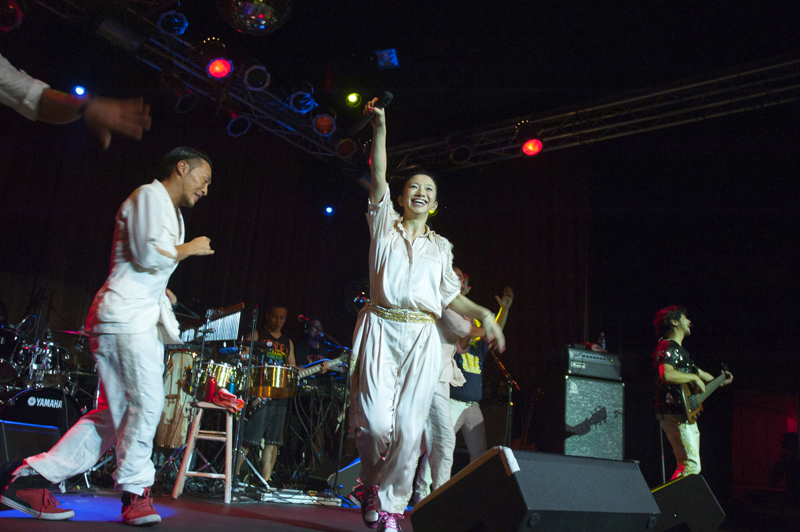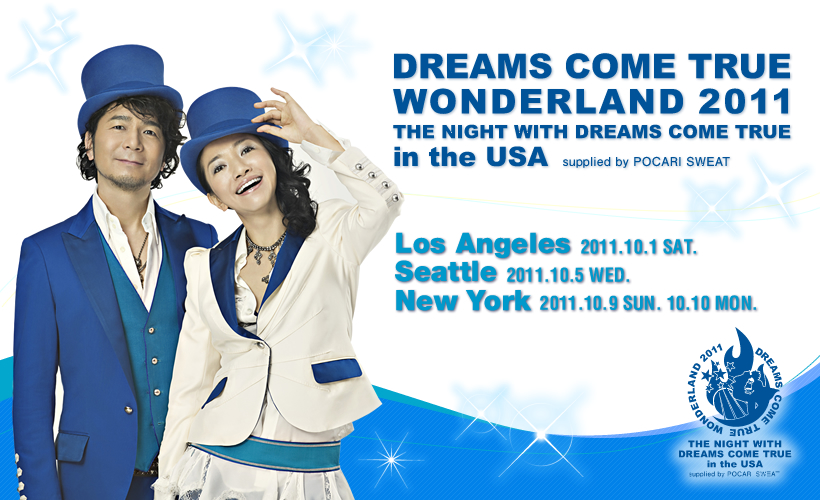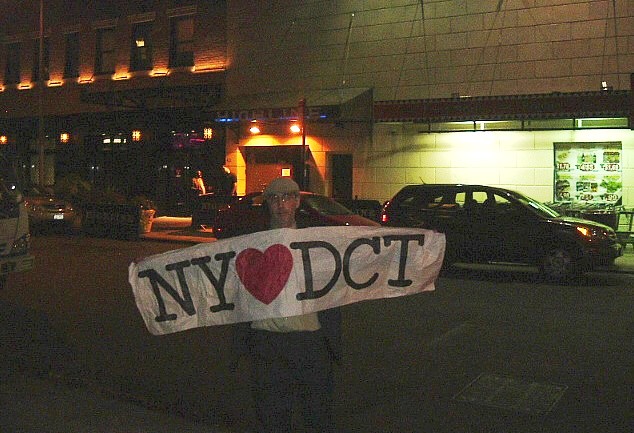JQ Magazine: Concert Review – DREAMS COME TRUE in New York City
By David A. in Virginia, special to JQ magazine.
Japanese mega-band DREAMS COME TRUE (ドリームズ・カム・トゥルー a.k.a. ドリカム) made a very rare U.S. appearance at the Highline Ballroom in New York City on October 9, the first of two shows that sold out within days of their announcement in July. Many thanks to fanpage DCT Joy for notifying its members of this wonderful event. For those of us not in New York, Los Angeles, or Seattle, we otherwise might not have known about it.
At dusk, around 6:30, the line already was down the block for admission to the inconspicuous Highline Ballroom in Chelsea. On this unseasonably warm October Sunday evening, the anticipation was palpable, the “DCT Joy” bringing alive the night. One walks upstairs to the ballroom, spare and easy to navigate. The management asks those seated on the floor of the “pit” to stand so that the crowd can fill the room.
First of all, a big shout-out to Justin Tedaldi (Kobe-Shi CIR, 2001-02) at JQ magazine. This reviewer cannot thank you enough. Also, thanks to Reiko from the DCT organization for her kind words.
Prior to the show, the house PA played a recording of some of DCT’s most well-known melodies, such as “Ano Natsu no Hanabi” and “Ureshii! Tanoshii! Daisuki!”, performed on soft bells.
Promptly at 8:00, introductions were made first by a woman in Japanese, to great enthusiasm from the audience; then a man said, “New York City! Are you ready for DREAMS COME TRUE?!” “A theme of the WONDERLAND” played as the fifteen-piece band-and-dance ensemble walked on stage, followed by Masato Nakamura (中村 正人). Although the Highline Ballroom has a standing capacity of 700, with a few dozen dinner tables on the balcony, the roar from the crowd was as if they were in an arena. With the theme concluded, Miwa Yoshida (吉田 美和) arrived, with her hair tied back and wearing a loose-fitting, light pink outfit; and, with her familiar exclamation “DREAMS COME TRUE in WONDERLAND….!!!”, the band launched into a heavy version of “Nando Demo,” as the crowd danced, waved, and cheered, encouraged by Miwa in all of her boundless energy.
If you’ve watched live videos on YouTube from DCT’s career, you have seen their many huge and elaborate custom-designed stages and their intricate choreography, and you have seen how all performers, especially Miwa, have complete command and control of the settings, never intimated or overwhelmed. Even without the elaborate production, and crowded as they were on the small stage, the performance was not lacking with any of the energy or musical qualities; we saw that the big productions augment the performance, but are not the heart and soul of the show. It is the people, the artists, from the duo of Miwa and Masa to every supporting band member, who contribute the sound and the movement that make DCT one of the most exciting live acts ever.
Miwa would lead the audience in familiar waves, gestures, and sing-alongs, especially during the ever-popular live hits “Kessen Wa Kinyoubi” and “Ureshii! Tanoshii! Daisuki!”, although the show clearly was choreographed in most numbers. As other reviewers online have commented, DCT and their band looked to be having so much fun onstage!

Miwa Yoshida, center, and Masato Nakamura, right, of DREAMS COME TRUE at New York's Highline Ballroom Oct. 9, 2011. (Mark Higashino)
After three numbers, Miwa took time for extended greetings to the audience (“New York Wonder Babies”), mostly in Japanese. As translated for this reviewer (thank you, Justin), Miwa said that they were not sure how the audience would react; the positive enthusiasm for them truly was “Wonderland,” and she wanted to take everyone’s feelings to Japan with her. Masa, wearing a multi-colored outfit, spoke mostly in English, charming the audience with his good-natured self-deprecating humor; he mentioned also that he had lost his voice, and that his apartment in New York was being renovated.
As other reviewers have noted, the show contains a mix of older and newer material, and well- and lesser-known songs, often with creative liberties taken in the arrangements, some unusually “heavy” or “hard.” One never knew what to expect next—it was “unpredictable” in the best way.
MC Marcellus Nealy deftly shifted between supporting and lead roles; he had a good rapport with Miwa and the other performers. The saxophonist who plays the great solo in the YouTube video “DREAMS COME TRUE WONDERLAND 2007” added many nice, smooth, emotional, and flawless fills and solos to several of the numbers, as well as leading the five-piece DCT Horns in tight arrangements. The guitarist, Juon, on hire from another Japanese group called Fuzzy Control, fit in seamlessly, and at one point delivered a fiery solo. The male vocalist, Nobuyoshi Nakazawa, who has been with the group since at least 2007, was with DCT at this show, also playing acoustic and electric guitars. The woman drummer, Satoko from Fuzzy Control, who appears in videos from the 20th Anniversary Tour two years ago, was with them at this show; petite and with a perpetual cheerful smile, one might not have expected her to “kick it out” with such power and intensity. She and Masa were an ideal pair for an extremely tight and heavy rhythm section.
Masa’s keen sense of harmonic arrangement and tasteful bass lines that critically define the character of the songs always have been part of the indispensable mix of personalities, visions, and talents that have distinguished DREAMS COME TRUE. At these live volumes, the importance of Masa’s bass guitar truly stood out as being on an equal footing with Miwa’s melodies, lyrics, and vocal deliveries. DREAMS COME TRUE is a genuine duo of necessary and complementary parts, and Masa’s smooth handling and control of the six-string puts him in the leading ranks of rock bass guitarists.
Reviews of the earlier shows noted some sound problems. At the Highline Ballroom, all voices and instruments (both acoustic and electric/electronic) were mixed and balanced perfectly, for that “big sound” that has defined DCT live and on record. That they could vary the arrangements and instrumentation and still have this level of excellence developed in a relatively short time demonstrates once again how seriously they take every detail of their craft.
Miwa, always smiling, generously shared credit and attention with the supporting band. She was full of aerobic energy all night, frequently mirroring the dancers’ movements (as in “Kessen Wa Kinyoubi”), and interacting with the dancers spontaneously and rehearsed. Miwa’s voice was flawless in pitch, dynamics, and emotional expressiveness, and never wavered even when she was striving for the maximum. She is a “natural” who has spent decades perfecting her talents; in this unedited, unenhanced, undiluted intimate setting, whatever ingredients comprise “star quality” were shining with abundance; and she was so radiantly beautiful, she confirmed what not enough people in the U.S. know: that Miwa Yoshida belongs among the greatest popular music vocalists.
As the show progressed with increasingly heavy arrangements, suddenly the brass and woodwinds began playing the DCT Horns’ part from the end of “Kessen Wa Kinyoubi”—Marcellus reminded us, “Because it’s Sunday night!” and the crowd’s enthusiasm was unstoppable. It captured all the spectacle of the best live DCT shows, there in a small ballroom.
Most astonishing was the revision of this timeless classic: In the middle of the song, Miwa began singing with an entirely, completely different melody, as the band accompanied with a completely different rhythmic and harmonic instrumental arrangement; then, suddenly, they reverted to the original composition. On cue, most of the audience joined in the “vocal endurance” line near the conclusion (“Ni-na-na ni-na-na….nowwwww!”), as the song ended in a great climax of light, sound, and motion. Where to go from there?! All that was left was “Ureshii! Tanoshii! Daisuki!”—hands waving, heads bopping, the crowd was on fire with full delight as Miwa delivered her most heartfelt performance of the song that, after 20 years, still is the crown jewel of the DREAMS COME TRUE oeuvre. Joining hands and taking their bows, Miwa, Masa, and their band slowly left the stage that provided a treasured night of popular music at its best. (But not before thrilling the audience one last time with a two-song encore.)
Now that the ’90s are becoming part of the “classic rock” format, it is time to note that most people outside of East Asia do not know that DREAMS COME TRUE was the most popular rock ensemble of the 1990s. In fact, within popular music of the 1990s, their exact contemporary Garth Brooks is their only real rival in terms of commercial success. What if events such as this “WONDERLAND 2011” tour of the United States could initiate a belated but long-overdue and deserved appreciation of DREAMS COME TRUE in the U.S.?
Most people who have seen DCT in Japan have seen them in large arenas or sports stadiums, which means necessarily that it is a “distant” experience for most in attendance. On the floor at the Highline Ballroom, the viewers furthest away were about 50 feet from the stage. Although we in the U.S. have fewer opportunities to see DCT, they are extremely rare opportunities to see one of the all-time greats “up close” and with an unforgettable immediacy.
David Lee Roth once said, “You should never leave the audience wanting more; the audience should leave the arena completely drained, saying, ‘Wow—that was the most incredible thing I’ve ever seen!’” After only two hours, before we knew it, the DCT show was over. We could have continued watching all night; and, yet…”Wow—that was the most incredible thing I’ve ever seen!” (You are right, Justin—our dreams came true.)
Thank you, DREAMS COME TRUE. The USA loves you. Come back soon!
Visit Dorikamu online at www.dreamscometrue.com.




Comments are closed.